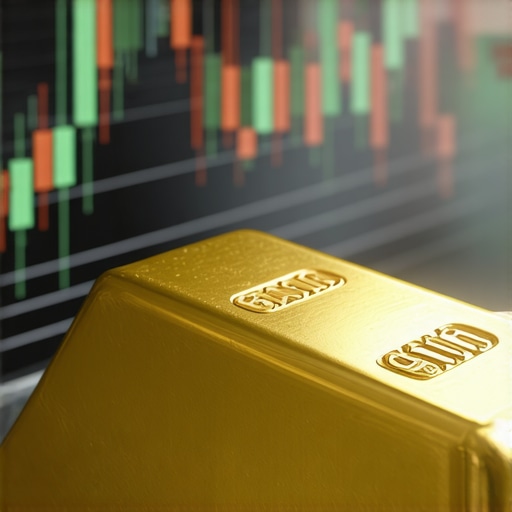Understanding Gold Demand Trends in Today’s Market
As an investor, staying ahead of the curve in the gold market is crucial for making informed decisions. Understanding gold demand trends is essential for predicting price movements and optimizing your investment strategy. The dynamics of gold demand are influenced by various factors, including economic conditions, geopolitical tensions, and changing consumer preferences.
Recent years have seen a resurgence in gold’s popularity, often attributed to its status as a safe haven asset during periods of economic uncertainty. Investors are increasingly looking to gold as a hedge against inflation and currency fluctuations. In fact, many financial experts recommend diversifying portfolios with gold to mitigate risks associated with traditional investments.
The Role of Economic Indicators in Gold Demand
Economic indicators such as inflation rates, interest rates, and economic growth play a significant role in shaping gold demand trends. For instance, when inflation rises, the purchasing power of fiat currencies diminishes, prompting investors to flock to gold as a more stable store of value. This trend has been particularly evident in recent years as central banks around the world have adopted looser monetary policies.
Moreover, the performance of the stock market can also impact gold demand. During market downturns, many investors pivot towards gold, viewing it as a safer alternative. This behavior underscores the inverse relationship often observed between gold prices and stock market performance.
Geopolitical Factors Influencing Gold Demand
Geopolitical tensions and uncertainties can lead to increased demand for gold. Events such as wars, trade disputes, and political instability often drive investors to seek refuge in gold. For example, during times of crisis, gold prices typically surge as market participants seek security.
Additionally, the actions of central banks can drastically affect gold demand. When central banks increase their gold reserves, it signals confidence in gold as a reliable asset, often leading to a ripple effect in the market. This behavior illustrates why understanding the intricacies of global politics and central banking policies is vital for investors looking to navigate gold demand trends effectively.
Consumer Demand for Gold: Cultural and Economic Perspectives
Consumer demand for gold, particularly in countries like India and China, is another significant factor influencing global gold demand trends. In these regions, gold is not only viewed as an investment but also as a cultural symbol, especially during festivities and weddings. The demand spikes during these periods, affecting overall market prices.
As an investor, being aware of these cultural factors can provide valuable insights into potential price movements. For instance, with the upcoming wedding season in India, a rise in gold demand can be anticipated, potentially influencing global prices.
In conclusion, understanding gold demand trends is essential for any investor looking to navigate the complexities of the gold market. By considering economic indicators, geopolitical factors, and cultural influences, investors can make informed decisions that align with their financial goals. For a deeper dive into gold investment strategies, you may find our guide on Mastering Gold Investment Strategies: Tips for Beginners helpful.
Analyzing Gold Supply Dynamics and Its Impact on Market Trends
The supply side of the gold market is equally important as demand when it comes to understanding price movements. Factors such as gold mining production, recycling rates, and geopolitical events can have significant effects on gold availability and, consequently, its market price. In this section, we will delve into the intricacies of gold supply and how it interacts with market trends.
The Role of Gold Mining in Supply
Gold mining is the primary source of new gold entering the market. It involves the extraction of gold from ores, and the volume of gold mined can influence prices significantly. High production rates tend to stabilize prices, while declines in mining output can create supply shortages, pushing prices upward. Furthermore, geopolitical factors, such as mining regulations and labor strikes in major producing countries, can lead to fluctuations in production levels.
For instance, countries like China, Australia, and Russia are among the largest gold producers, and any disruptions in these regions can have far-reaching effects on global gold supply. Investors should closely monitor mining activities and geopolitical stability in these areas to anticipate potential price shifts. Additionally, understanding the dynamics of the gold market can provide deeper insights into how these factors interplay.
Recycling and Its Impact on Gold Supply
Recycling plays a crucial role in the gold supply chain, accounting for a significant portion of the total gold supply. As gold prices increase, recycling rates typically rise as individuals and businesses seek to capitalize on the higher value of their gold holdings. This trend can help alleviate some supply pressures in the market.
Moreover, the recycling of gold from old jewelry, electronics, and industrial applications can contribute to a more sustainable gold supply. Investors should consider the implications of recycling trends, as they can affect the overall market dynamics. For example, a surge in gold recycling due to high prices could lead to a temporary stabilization of gold prices, mitigating the impact of decreased mining output.
Geopolitical Factors Affecting Gold Supply
Geopolitical events can also significantly influence gold supply. Political instability in major gold-producing countries can lead to supply disruptions, which can cause prices to soar. For instance, sanctions, civil unrest, or changes in government policies can impact mining operations and lead to reduced output.
Understanding these geopolitical risks is essential for investors. Keeping an eye on global news and its effects on the gold supply chain can help investors make informed decisions. For more on how geopolitical factors can influence gold prices, check out our detailed analysis on central banks and their role in gold pricing.
Conclusion: The Interplay of Supply and Demand in Gold Investments
In conclusion, the interplay between gold supply and demand is a fundamental aspect of the gold market that investors must consider. By analyzing mining production, recycling trends, and geopolitical events, investors can better navigate the complexities of gold investments. Understanding these dynamics not only equips investors with the knowledge to make informed decisions but also helps them anticipate market movements effectively. For those looking to enhance their gold investment strategies, our guide on top gold investment strategies provides valuable insights to consider.
Exploring Factors Driving Gold Demand in Today’s Market
Gold demand is influenced by various factors that extend beyond mere investment interest. Understanding these factors can empower investors to make informed decisions in the fluctuating gold market. In this section, we will examine the key drivers of gold demand and their implications for investors.
Investment Demand: The Role of Gold as a Safe Haven
During times of economic uncertainty, investors often turn to gold as a safe haven asset. The perception of gold as a hedge against economic turmoil and inflation drives significant demand from both individual and institutional investors. As global markets experience volatility, the demand for gold tends to increase, leading to price surges. This behavior highlights the importance of monitoring economic indicators and geopolitical events that can trigger investor sentiment towards gold.
For more insights on how to navigate economic uncertainty with gold investments, refer to our comprehensive guide on buying gold during economic uncertainty.
Jewelry Demand: Cultural and Economic Influences
The jewelry sector remains a significant contributor to gold demand, especially in countries with rich cultural traditions such as India and China. In these regions, gold jewelry is often associated with festivals, weddings, and other significant life events. Economic growth in these countries can lead to increased disposable income, further boosting gold jewelry sales.
Understanding the cultural significance of gold in these markets can help investors anticipate fluctuations in demand tied to seasonal buying patterns. For example, the festive seasons in India typically see a spike in gold jewelry purchases, impacting overall market dynamics. Keeping abreast of these trends can further inform your investment strategies.
Technological Demand: Gold in Electronics and Industry
Gold’s unique properties make it invaluable in various industrial applications, including electronics and medical devices. As technology advances, the demand for gold in electronic components continues to grow. This industrial demand can sometimes counterbalance fluctuations in investment demand, creating a more stable market environment.
Investors should consider the implications of technological advancements on gold demand, as these developments can lead to increased consumption in sectors that rely heavily on gold, such as renewable energy and high-tech manufacturing.
The Role of Central Banks in Shaping Gold Demand
Central banks play a pivotal role in the gold market by holding substantial gold reserves as part of their monetary strategies. Their buying and selling activities can significantly influence gold prices. When central banks increase their gold reserves, it often signals a lack of confidence in fiat currencies, driving up demand and prices.
For investors, understanding central bank policies and their impact on gold demand is crucial. Keeping track of global central bank actions can provide insights into potential market movements. For an in-depth analysis of central bank influences on gold prices, explore our article on the role of central banks in gold price fluctuations.
Conclusion: The Interconnected Nature of Gold Demand Factors
The dynamics of gold demand are multifaceted and influenced by a variety of economic, cultural, and technological factors. By comprehensively analyzing these drivers, investors can better position themselves to capitalize on market opportunities. Understanding how investment demand, jewelry trends, industrial uses, and central bank activities intertwine will enhance your gold investment strategies and decision-making processes.
Understanding Gold Supply Dynamics and Their Impact on Prices
The supply of gold is a crucial factor in determining its market price. Investors must grasp how supply dynamics, including mining production and recycling, influence gold availability. In this section, we will dissect the key elements affecting gold supply and their implications for investment strategies.
Mining Production: The Backbone of Gold Supply
Gold mining remains the primary source of new gold supply in the market. Global production levels can fluctuate due to various factors, including geopolitical stability, exploration success, and mining costs. Countries like China, Australia, and Russia are among the top gold producers, and any changes in their mining output can significantly affect global supply.
Moreover, as gold deposits become harder to find and extract, mining companies may face increasing operational costs. This scenario can lead to reduced production rates, which in turn may restrict supply and push prices higher. For investors, staying informed about mining trends and production forecasts is essential. It can help anticipate potential price movements based on supply constraints.
Recycling Gold: A Sustainable Supply Source
Recycled gold accounts for a significant portion of the global supply, often exceeding new mine production. The recycling process involves reclaiming gold from old jewelry, electronic waste, and other sources. As environmental concerns grow, the push for sustainable practices in gold sourcing has become more pronounced.
Investors should consider the role of recycled gold in the market, as it can help stabilize prices during periods of high demand. Additionally, understanding the factors that drive gold recycling, such as fluctuating prices and economic conditions, can provide valuable insights into market trends.
The Influence of Geopolitical Events on Gold Supply
Geopolitical events can have a profound impact on gold supply by disrupting mining operations or trade routes. For instance, conflicts in gold-producing regions or changes in government policies can lead to reduced output and increased uncertainty in the market. Investors must monitor political developments in key gold-producing countries to assess potential risks to supply.
Furthermore, trade policies and international relations can affect gold imports and exports, which influence overall market dynamics. Understanding these geopolitical factors is crucial for investors looking to navigate the complexities of gold investments. For a deeper dive into how geopolitical events affect gold markets, check out our article on how gold prices are affected by global supply and demand.
Conclusion: The Interplay of Supply Factors in Gold Investment Strategies
The supply dynamics of gold are intricate and influenced by mining production, recycling methods, and geopolitical factors. By thoroughly analyzing these elements, investors can better position themselves to navigate the market effectively. Understanding how supply trends interact with demand can enhance investment strategies and help in making informed decisions in the ever-evolving gold market.
Frequently Asked Questions About Gold Supply and Price Dynamics
1. What factors influence the price of gold?
The price of gold is influenced by several factors including mining production, recycling rates, inflation, interest rates, and geopolitical stability. Understanding these elements can help investors make informed decisions.
2. How does mining production affect gold prices?
Mining production directly impacts the supply of gold in the market. When production levels are high, it can stabilize or lower prices, while decreased production due to political issues or high costs can lead to price increases.
3. Why is recycled gold important for the market?
Recycled gold plays a crucial role in the gold supply chain, often accounting for a large percentage of the total supply. It can help mitigate price volatility during periods of high demand, making it an essential element for investors to consider.
4. How do geopolitical events impact gold prices?
Geopolitical events, such as conflicts, trade disputes, or changes in government policies in gold-producing countries, can disrupt supply and create uncertainty in the market, often leading to price fluctuations.
5. What role does inflation play in gold pricing?
Gold is often viewed as a hedge against inflation. When inflation rises, investors tend to flock to gold, increasing its demand and price. Understanding this relationship is vital for those looking to invest in gold.
6. Are there any seasonal trends in gold prices?
Yes, gold prices can exhibit seasonal trends, particularly linked to jewelry demand during festivals and holidays. Such trends can impact short-term price movements, making it important for investors to monitor seasonal patterns.
7. What is the relationship between gold and the US dollar?
Gold prices often have an inverse relationship with the US dollar. When the dollar weakens, gold becomes cheaper for foreign investors, which can increase demand and drive up prices.
8. How can investors track gold supply and demand trends?
Investors can track gold supply and demand trends by following market reports, analyzing mining output and recycling statistics, and keeping an eye on geopolitical developments. Additionally, gold-focused financial news outlets provide valuable insights.
9. Why is understanding gold supply dynamics crucial for investors?
Understanding gold supply dynamics helps investors anticipate price movements and adjust their strategies accordingly. By analyzing mining production, recycling rates, and geopolitical factors, investors can make more informed decisions in the gold market.
10. Where can I find reliable information about gold investments?
Reliable information about gold investments can be found on trusted websites such as the World Gold Council, Kitco, and financial news platforms like Bloomberg and Reuters. Additionally, academic literature and expert analyses can provide valuable insights.
Authority Resources for Gold Investment Insights
For investors looking to deepen their understanding of gold supply and price dynamics, the following authoritative resources offer valuable information:
- World Gold Council – A leading authority on gold market insights and trends.
- Kitco – A trusted source for gold prices and market analysis.
- Bloomberg – Offers comprehensive financial news and insights, including gold market reports.
- Reuters – Provides up-to-date news and analysis on commodities, including gold.
- Investing.com – Features market data and forecasts relevant to gold investments.
- Financial Times – Offers expert commentary and analysis on global financial markets.
- JSTOR – A digital library containing academic papers related to economic trends and gold investment.
Conclusion: Navigating Gold Investment with Informed Strategies
In conclusion, understanding the intricacies of gold supply dynamics and their impact on prices is paramount for investors. By analyzing factors such as mining production, recycling sources, and geopolitical events, investors can develop informed strategies that enhance their decision-making in the gold market. As you navigate the complexities of gold investments, remember that staying updated with market trends and leveraging authoritative resources will empower you to make sound investment choices in this ever-evolving landscape.










